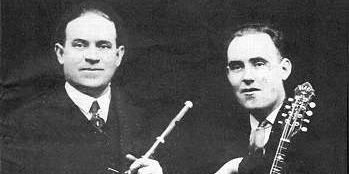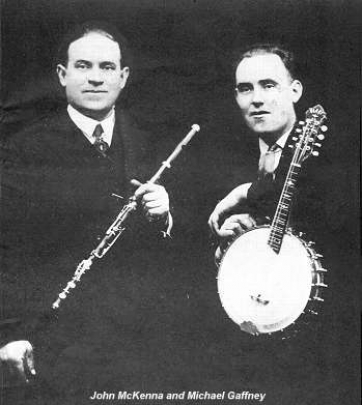
1880–1947

John McKenna was the most renowned Irish flute player of the 78 rpm era and his punchy rhythmic style remains influential to this day. He was born in 1880 in the townland of Tents, Tarmon in County Leitrim near the spot where the borders of Counties Sligo, Leitrim and Roscommon meet. There was no lack of good musicians, especially flute players, in the area. Piper Michael Gallagher and accordionist Margaret McNiff were other local players who, like McKenna, would go on to record 78 rpm discs in New York.
McKenna left Ireland for the first time in 1904, settling with his elder sister Mary’s family on Manhattan’s Upper East Side. In 1909, when he had acquired U.S. citizenship, he returned to Leitrim to marry Mary Jane Keveaney from Drumshanbo. Back in New York, the couple would have eight children.
After a few years working as an electrician and shipyard worker, McKenna launched a career as a New York Fire Patrolman in 1920. Not long after that, he launched his career as a recording artist. Around 1922, with Sligo-born fiddler (and fellow fireman) Barney Conlon, he recorded three duet sides released by the short-lived New Republic label. He returned to the studio fifteen more times, recording dozens of sides for Gennet, Columbia and Decca, with some of those recordings reissued on other labels. On some early sides, in addition to recording on the standard concert flute, “Fireman John McKenna” played a short F flute or tin whistle, and even sang and lilted. His duet recordings with tenor banjo / banjo-mandolin player Michael Gaffney (from Arigna, Roscommon) and Sligo fiddle great James Morrison are among the finest of the 78 rpm era.
Mary Jane McKenna died in 1926 as a result of complications in her ninth pregnancy. Not long after, McKenna quit the Fire Patrol, went to work as a machinist for the IRT subway line and pulled back from performances and recordings. Even when the pressures of family obligations eased and he returned to playing in public, the impact of the Great Depression restricted him to very more few commercial recordings. His final sides, in 1937, were cut with Sligo flute player Eddie Meehan, Roscommon-born fiddler Larry Redican and U.S.-born pianist Frank Fallon as “Eddie Meehan’s Rosaleen Quartet.”
John McKenna paid a lengthy visit to Ireland in 1938. He met and played with musical friends in Dublin, where he was given a live ten-minute slot on Radio Éireann, before returning home to Leitrim. In his final years, McKenna lived with his daughter Madeline and her family on the Upper East Side of Manhattan. He died following a heart attack in 1947 and is interred in Calvary Cemetery in Queens.
